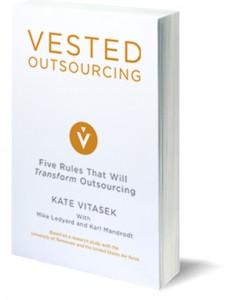Is there a better way to outsource?
That is the question that the US Air Force asked University of Tennessee researchers. As part of a research project funded by the Air Force, researchers studied some of the world’s most successful outsourcing relationships.
The findings? The world’s best did things a bit differently, starting with creating a strategic and highly collaborative relationship with their service providers to create value for the company outsourcing and the service provider. In short – creating the nebulous “win-win” relationship researchers coined as “Vested Outsourcing” – or simply “Vested” for short.
But what exactly is Vested? First and foremost, it is a fundamental business model paradigm shift in the ways in which a company that outsources and its suppliers do business. In a Vested agreement everyone works together on shared goals to drive innovation, create value and reward success. What Lean has done for manufacturing in changing the business world since 1990, the Vested movement is doing for outsourcing and business relationships.

The Vested business model uses a hybrid of outcome-based, shared-value principles and relational economics. In a Vested environment a company develops a common solution and a common bond with a supplier or service provider based on mutual advantage to achieve desired outcomes. The more successful the company that is outsourcing, the more successful the service provider—ergo Vested.
So how does it work? UT’s research outlined five key “rules” for a successful Vested agreement, setting the stage for companies to take their outsourcing relationships to the next level of collaboration and value. The Five Rules are featured in the book Vested Outsourcing: Five Rules That Will Transform Outsourcing, published in 2010 by Palgrave Macmillan. The rules and a brief explanation of them follow:
- Focus on outcomes, not transactions: Transaction-based approaches are widespread in today’s outsourcing business environment. Conventional outsourcing agreements are typically at a detailed per-transaction level, paying either for a business task or on a per-headcount basis. But these models are not necessarily the most cost-effective. Real weaknesses in transaction-based arrangements emerge when any level of added complexity, variability, and mutual dependency is part of the transaction. A transaction-based approach cannot produce perfect market-based price equilibrium in variable or multidimensional business agreements, such as global supply chains and complicated logistics arrangements. This is why organizations are exploring other types of sourcing business models, including outcome-based approaches, which is the basis of Vested.
- Focus on the WHAT not the HOW: Another departure from the conventional approach: Under Vested a company that is outsourcing specifies what it wants and moves the responsibility of determining how the work gets delivered to the service provider.
- Clearly defined and measurable desired outcomes: Once mutually agreed-upon desired outcomes are established by the parties, the important work of monitoring and measuring comes into play. This rule ensures that the parties know when they have achieved their goals by clearly understanding how to measure and monitor success.
- Pricing model with incentives that optimize for cost/service tradeoffs: While there is no one-size-fits-all pricing model in Vested, the parties must have a properly structured pricing model that incorporates incentives for the best cost and service trade-off. A fair pricing structure is reached through cooperation, flexibility, and innovative thinking. Inherent in the Vested model are rewards for service providers to invest in process, service, or associated products that will generate returns in excess of agreement requirements.
- A governance structure with insight, rather than oversight: Governance with insight, collaboration and flexibility is the linchpin that makes all the rules work effectively together. That’s why this rule is perhaps the most important. A sound governance structure provides consistent management along with cohesive policies, processes, and decision rights that enable parties to work together effectively and collaboratively. A governance framework enables the parties to manage performance and achieve transformational results throughout the life of the agreement.
The first Vested book was followed by a more detailed manual describing how parties can bind their Vested agreement in a formal contract, as explained in The Vested Outsourcing Manual.
The Vested model works for companies both large and small, for government and non-governmental organizations – and even for charitable institutions.
To see eight examples of Vested in action, turn to the recently released book, Vested: How P&G, McDonald’s and Microsoft are Redefining Winning in Business Relationships.
Written by Kate Vitasek. Kate Vitasek is a faculty member at the University of Tennessee’s Center for Executive Education and is the author of Vested Outsourcing: Five Rules That Will Transform Outsourcing and The Vested Outsourcing Manual, both published by Palgrave Macmillan. A third book, Vested: How P&G, McDonald’s and Microsoft are Redefining Winning in Business Relationships, published in September.

